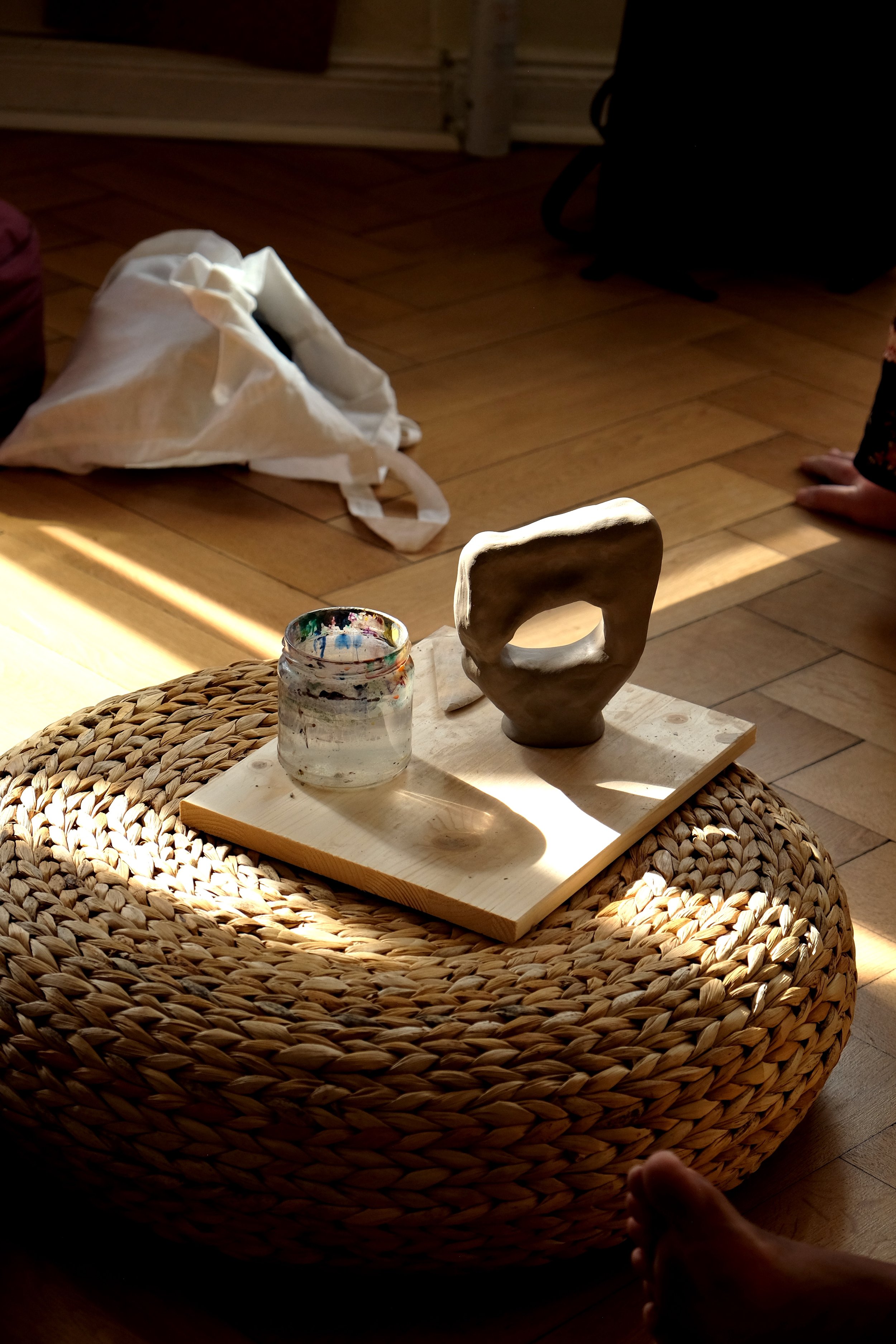Unlocking the Senses: Embarking on an Artistic Journey with Clay for Mental Well-being
“Touch comes before sight, before speech… It is the first language and the last, and it always tells the truth”
Discover a true connection between creativity and transformation
Clay holds within the power of all of the elements
How touch can enable us to access embodied memories
Pottery and the embodied memory
Haptic perceptions activate neurological pathways and promote mindfulness
Pottery as a gateway to self-expression
Pottery stimulates the release of dopamine and serotonin
Induce a meditative state through pottery
Reduce anxiety, lower heart rate and blood pressure
You are looking for a pottery course in Berlin?
Pottery at Team Events in Berlin
There is a sweet spot in art where artistic expression meets a sensory experience. And one of my favorite ways to reach that spot is due to working with clay.
Discover a true connection between creativity and transformation
There is a sweet spot in art where artistic expression meets a sensory experience. And one of my favorite ways to reach that spot is due to working with clay. Through the malleability of this medium, we can discover a profound connection between creativity and transformation in pottery. Every move of our fingers have consequences on a three-dimensional level, giving us the opportunity to see our work in this world - and thus ourselves - from different perspectives. Transformation happens at various moments in the artistic process, whether during inspiration, the creative phase. self-reflection, or artistic development. Often, however, transformation only becomes truly tangible when it manifests itself in a form, such as a clay figure.
2. Clay holds within the power of all of the elements
That’s why I offer pottery classes in Berlin, where participants can get to know the medium, and dive into its mystical realm. Where one can meet themselves in a different way, where one can learn to let go and to reshape what is given. Clay holds within the power of all of the elements and experiences a profound transformation through them: Coming from over a 1000 meter under the earth is contains a grounding energy. Mixed with water it becomes softer to a state where it can wash away. In connection to air it hardens and in fire in reaches it’s finite form. Becomes stronger. Its healing powers had been used throughout history in different cultures all over the world.
3. How touch can enable us to access embodied memories
Touch is one of the fundamental human experiences: When we enter this world we know no words or gestures. Language is very much strange to us. What we do know though is touch. It is the basis for secure attachment, linked to earliest body memories, to the ability to handle the world and regulate emotions. Even Freud knew that the body could keep memories the mind can easily forget, which makes clay especially suited for the understanding and treatment of trauma.
4. Pottery and the embodied memory
Furthermore, the act of pottery making can be considered a form of embodied cognition, where the mind and body are closely intertwined. Embodied cognition is a concept from cognitive science and psychology that states that our thinking does not just take place in the brain, but is intimately connected to our bodies and sensory perceptions. It assumes that our physical interaction with the world and our bodily sensations have a significant impact on our cognitive processes, learning, and decision making.
Body memory can also store sensory information, such as the feel of certain surfaces or textures that occur during certain activities. This sensory memory can help us better execute movements or actions. At the same time, embodied memories can be associated with emotional experiences. When a particular movement or activity is associated with strong emotions, body memory can store those emotions and influence future executions of the movement.
The way we move and act is closely linked to our thought processes. Physical actions can help organize and process information. For example, drawing a sketch or creating a physical model can help us better understand complex concepts. The embodiment principle states that what we think and how we think about things is often influenced by what our body experiences and how it interacts with its environment. This means that the things we feel, touch, or do can influence our thoughts and affect the images in our minds. Through the creative aspect and sensory experience of pottery, certain non-conscious memories can be addressed and processed. Through the symbolic expressiveness of clay, we can create shapes and figures that represent their inner feelings or experiences, even if they are not fully aware of them.
5. Haptic perceptions activate neurological pathways and promote mindfulness
Using our hands as a tool for perception is called haptic perception. When our hands touch the soft, moist clay, a symphony of tactile sensations unfolds. The coolness at our fingertips, the gentle resistance beneath our palms, and the satisfying yielding of the material create a rhythmic dance of touch. With the touch of clay, receptors are naturally stimulated, and each movement of the hands provides instant feedback to the brain, triggering a complex interplay of neural pathways. Haptic perception provides non-verbal access to psychological and sensorimotor processes. This helps us stay anchored in the present moment, diverting our attention from stressors and promoting a state of mindfulness.
This is one of the reasons why pottery is so important in art therapy as well.
6. Pottery as a gateway to self-expression
The artistic process of pottery offers more than sensual pleasure; it is a means of self-expression and provides space for thoughts and emotions. Clay has the unique ability to absorb our energy, worries and stress as we work with it. With each pinch, roll or stroke, we release emotions, creating something tangible out of the intangible. Self-expression always has the goal of being seen or heard. Only when we feel understood do we feel safe. As soon as we find ourselves in distress - real or perceived - the opportunity to express ourselves becomes existential. Worries, fears, feelings - we want to communicate all of this. If nothing else, to get rid of it.
7. Pottery stimulates the release of dopamine and serotonin
Studies have shown that creative activities like pottery stimulate the release of neurotransmitters like dopamine and serotonin. These chemical messengers are associated with pleasure, reward and mood regulation. By modeling clay, we activate neural circuitry and promote feelings of pleasure and relaxation.
8. Induce a meditative state through pottery
In pottery, we are physically active, paying attention to every movement and touch of the clay. This encourages a form of mindfulness in which we consciously focus on the present moment. Many pottery techniques require repeated, rhythmic movements, such as centering the clay on the wheel or modeling by hand. The repeated movements of pottery making can induce a state of focused attention, similar to meditation, and quiet the inner noise, quieting and clarifying our thoughts. The pottery process is usually slow and requires patience. This can help slow the mind and distract from the fast-paced thoughts of everyday life.
9. Reduce anxiety, lower heart rate and blood pressure
As we mold and sculpt, our minds can find solace and clarity. This sustained focus directs our mind away from repetitive thoughts and worries. With each movement, stress can dissipate, anxiety can fade, and a sense of calm washes over us. Additionally, the rhythmic motions involved in clay work stimulate the parasympathetic nervous system, activating a relaxation response and lowering heart rate and blood pressure.
10. You are looking for a pottery course in Berlin?
Berlin is a city with many opportunities. If you want to learn pottery, it's not particularly difficult. Clay is one of the most forgiving materials, that lets you get away with a lot and can also withstand stronger emotions or aggression. I offer different workshops, including a pottery class where you work blindfolded and a Clay Healing Journey.
The Blindfolded Sculpting workshop takes you into a new world where you have to rely completely on your senses. Of course, I will give you plenty of opportunities to get to know the material and try it out beforehand. I will also give you enough help to prepare your clay figure for the kiln, or show you how a possibility for pottery without firing.
The Clay Healing Journey is a guided clay meditation dealing with the expression and release of pain and trauma that helps you navigate discomfort and manage your pain by also offering you a ritual to let go of what no longer serves you.
Pottery at Team Events in Berlin
Pottery in workshops or at team events offers a variety of benefits, both on an individual and group level. Here are some of the most important benefits:
1. Encouraging creativity: pottery encourages free expression and promotes creativity. Participants can let their imaginations run wild, which helps generate new ideas and approaches to problem-solving.
2. Stress relief: Working with clay can be extremely relaxing. It allows participants to relieve stress and relax, which can improve overall mood and well-being.
3. Teamwork: at team events, making pottery together encourages collaboration. Participants must work together to achieve common goals, which can strengthen team dynamics.
4. Perseverance and Creative Problem Solving: Shaping clay requires patience and perseverance, as it takes time and practice to learn pottery in a way that allows you to master all the techniques. This can strengthen the ability to persevere and overcome challenges. At the same time, many shapes can be made without any skill. Creative problem-solving is required and can be tested at this playful level.
5. Result orientation: The opportunity to create a physical work of art offers a clear result orientation. Participants can be proud of their finished product, which increases self-esteem.
You see, there are many ways you can benefit from pottery classes. Last but not least, don't forget that pottery is incredibly fun and people of all ages and backgrounds can have a wonderful time making pottery.
Interested in my Workshops or Team Events? Then check them out here.
Come and Create!
Read more:
References:
Cornelia Elbrecht (2021), Healing Trauma in Children with Clay Field Therapy: How Sensorimotor Art Therapy Supports the Embodiment of Developmental Milestones, North Atlantic Books, Berkeley California
Cornelia Elbrecht & Liz R. Antcliff (2014) Being touched through touch. Trauma treatment through haptic perception at the Clay Field: A sensorimotor art therapy, International Journal of Art Therapy, 19:1, 19-30, DOI: 10.1080/17454832.2014.880932
Hoffmann, M. (2016). Verkörperte Kognition. In: Kühler, M., Rüther, M. (eds) Handbuch Handlungstheorie. J.B. Metzler, Stuttgart. https://doi.org/10.1007/978-3-476-05359-6_18
Michal Sholt MA & Tami Gavron MA (2006) Therapeutic Qualities of Clay-work in Art Therapy and Psychotherapy: A Review, Art Therapy, 23:2, 66-72, DOI: 10.1080/07421656.2006.10129647

















